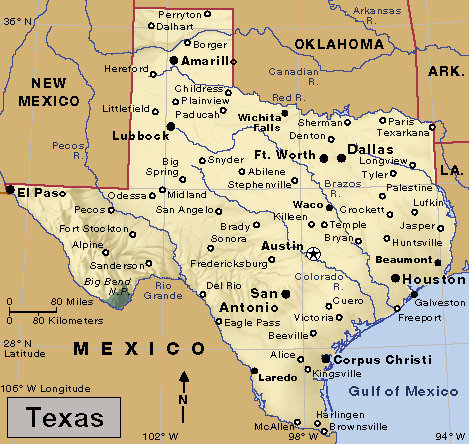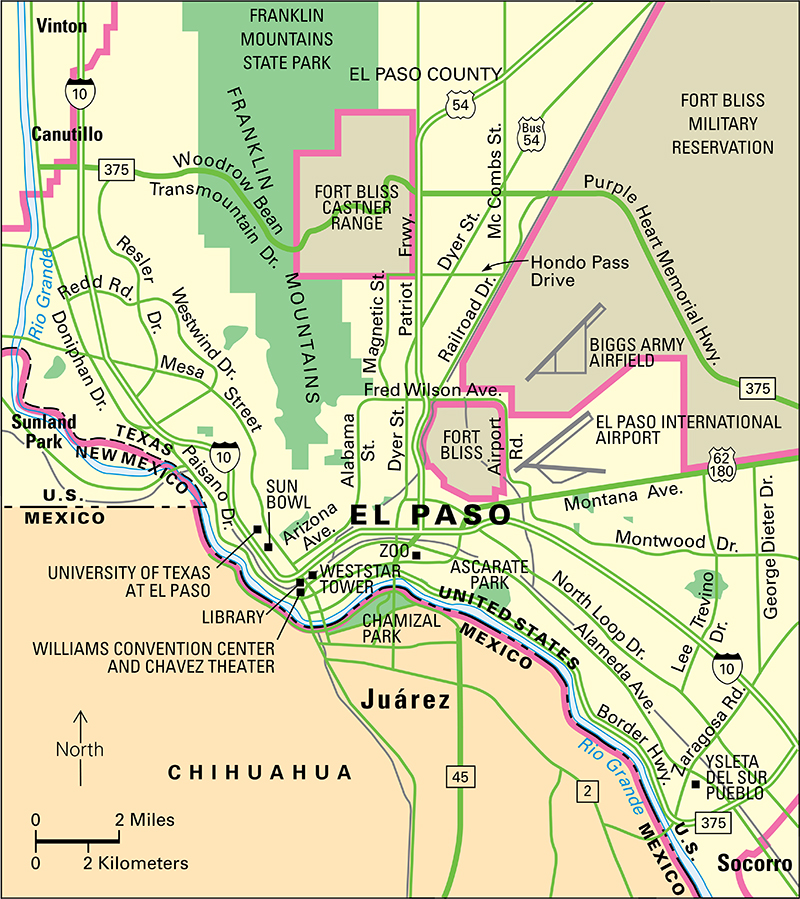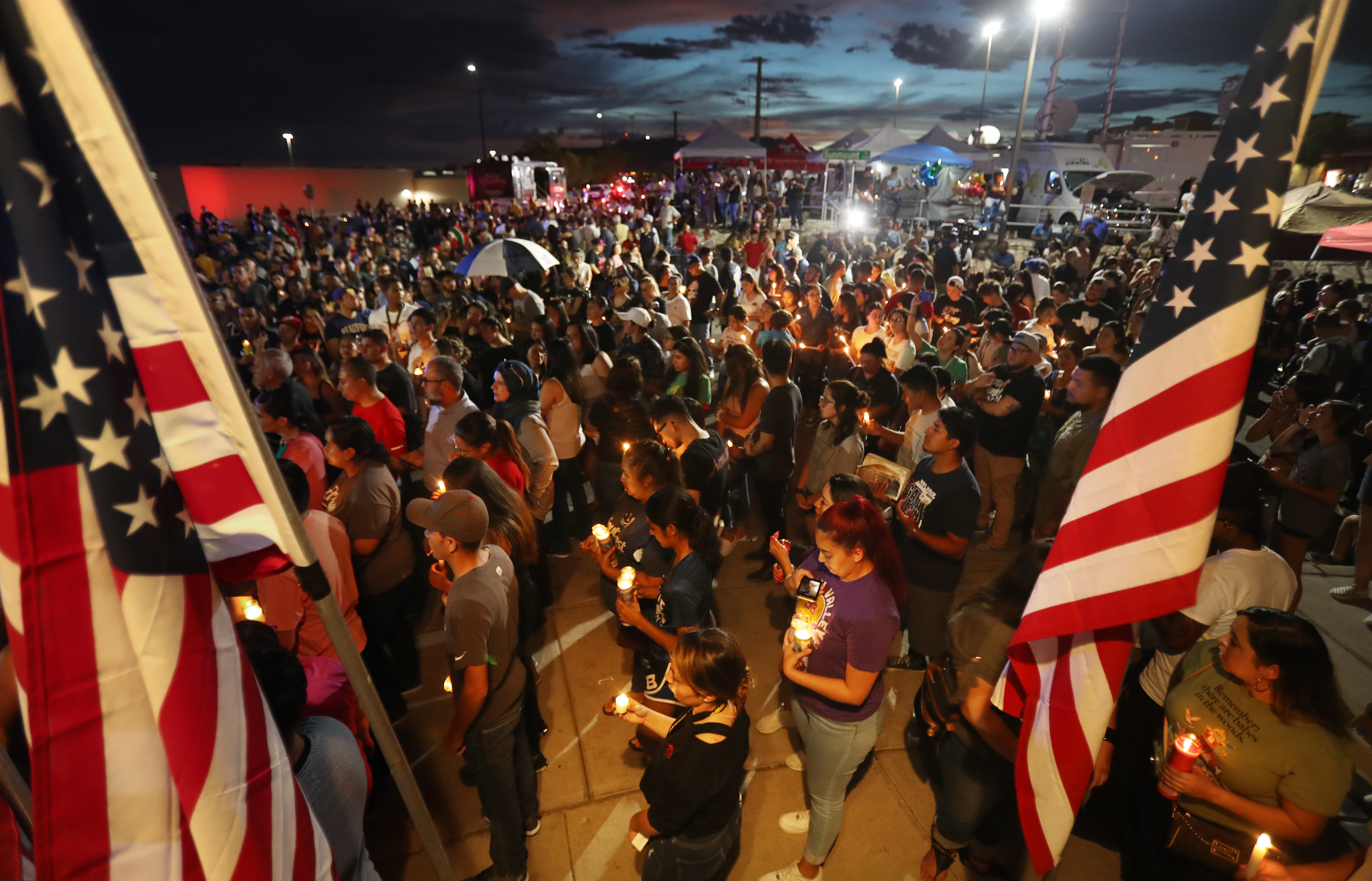El Paso << ehl PAS oh >> (pop. 678,815; met. area pop. 868,859) is a city in Texas that lies along the border between the United States and Mexico. It serves as a major gateway for travel and commerce between the two countries. It is also an important distributing and manufacturing center of the southwestern United States. El Paso sprawls along the north bank of the Rio Grande at the far western tip of Texas. It lies in a desert in a pass between the Franklin Mountains to the north and the Sierra Madre of Mexico to the south. Part of the city extends into the Franklins. El Paso’s sister city of Juárez, Mexico, lies across the Rio Grande.

In 1598, the Spanish explorer Juan de Oñate arrived at what is now El Paso. He named the area El Paso del Norte (the pass of the north). The pass became a major stop on El Camino Real (the Royal Highway) between Mexico City and the Spanish colonies of New Mexico.
The city.
El Paso, the seat of El Paso County, covers 258 square miles (668 square kilometers) of land. The El Paso metropolitan area covers 5,584 square miles (14,462 square kilometers) of land. San Jacinto Plaza, a traditional symbol of the city’s Spanish and Mexican heritage, is in the heart of downtown El Paso. The downtown also includes the Judson F. Williams Convention Center, the Abraham Chavez Theatre, the Plaza Theatre, and the 20-story WestStar Tower, the city’s tallest building. The University of Texas at El Paso, known for its Tibetan-style architecture, lies northwest of downtown. Fort Bliss, a major U.S. Army post, extends from northeast El Paso into New Mexico.

About 80 percent of the people of El Paso—called El Pasoans—have Hispanic ancestry, and both English and Spanish are spoken in much of the city. Other groups include African Americans and people of English, German, and Irish descent. Native Americans related to the Pueblo people of New Mexico live on or near Ysleta del Sur Pueblo, an Indian reservation, which is in the city.
Economy.
The government is a major employer in El Paso. Fort Bliss and other nearby military bases provide many civilian jobs. Hundreds of manufacturing companies operate in El Paso County. Major industries include food processing and oil refining. Factories also make electronics, machinery, metal products, wood products, and leather goods—especially Western boots. Farming, especially the growing of cotton and chiles, and cattle raising are important in the surrounding area. These activities employ thousands of El Pasoans seasonally.
Since the 1970’s, the economies of El Paso and Juárez have developed a major border industry known as the maquiladora or twin plants. Assembly plants in Juárez manufacture such products as automobile parts, clothing, and electronic equipment from materials produced in the United States. Workers in El Paso help transport raw materials into Mexico and return the finished products to the United States.
Railroads and truck lines provide freight service to El Paso. Amtrak passenger trains stop in the city, and several airlines serve El Paso International Airport. Major highways connect the city with other parts of the United States and with Mexico. Four bridges span the Rio Grande between El Paso and Juárez. El Paso has one daily newspaper, the El Paso Times.
Education and cultural life.
Public schools in the city of El Paso are divided into three districts: the El Paso Independent School District, Ysleta Independent School District, and Socorro Independent School District. The city also has many parochial and other private schools. It is the home of a campus of the University of Texas. The El Paso Public Library operates a main library and a number of branches.
El Paso has a symphony orchestra, an opera company, and a number of theater companies. In addition, the city operates the El Paso Museum of Archaeology, the El Paso Museum of Art, and the El Paso Museum of History. Fort Bliss has several museums of military history.
El Paso hosts many events each year. The Sun Bowl Parade occurs each Thanksgiving, and the Sun Bowl college football game is held each December. Major Mexican holidays are widely celebrated in El Paso. The city has dozens of parks and recreation facilities. The city zoo is in Washington Park. Ascarate Park, El Paso County’s largest, spreads across 448 acres (181 hectares) and includes a lake for fishing and boating.
Government.
El Paso has a council-manager form of government. Voters elect a mayor and eight other council members, all to four-year terms. The council appoints a city manager to carry out its policies. The city government gets much of its revenue from property taxes.
History.
Native American peoples known as the Manso and Suma lived in what is now the El Paso area when Europeans first arrived there. Juan de Oñate claimed the area for Spain in 1598 and named it El Paso del Norte. Spanish priests set up their first mission in the area in 1659, in what is now Juárez. In 1680, Pueblo people drove Spanish settlers out of northern New Mexico. The settlers, along with a group of Pueblos who later became known as the Tigua, fled to the Rio Grande. There, they founded Ysleta, now part of El Paso; and Socorro, now a suburb. Ysleta and Socorro were Texas’s first towns. In 1682, the first two missions in Texas were built near the present site of El Paso.
El Paso del Norte came under Mexican control in the early 1820’s after Mexico gained independence from Spain. In 1848, following the Mexican War, the Treaty of Guadalupe Hidalgo established the Rio Grande as part of the boundary between the United States and Mexico. The section of El Paso del Norte north of the river became the U.S. community of El Paso. The southern part, Mexican territory, was later renamed Juárez.
In 1848, the U.S. Army opened an infantry post, which became Fort Bliss in 1854. During the Civil War (1861-1865), the fort surrendered to the Confederacy, and a Confederate force marched north from there to invade New Mexico. After being defeated at Glorieta Pass in New Mexico in 1862, the Confederates abandoned Fort Bliss and retreated to San Antonio.
El Paso was incorporated as a city in 1873. It had 173 residents. A railroad arrived in the city in 1881 and helped cause a land boom. By 1890, 10,338 people lived in El Paso. The city had a reputation as a rough and rowdy border town where gunfights were common.
The population of El Paso continued to grow during the 1900’s. Employment opportunities with the railroad and in mining and ranching drew many people to the city. By 1910, the population had reached almost 40,000. In 1916, Elephant Butte Dam was completed across the Rio Grande about 132 miles (212 kilometers) north of El Paso. The reservoir created by the dam supplies water to parts of Texas, New Mexico, and Mexico. It helped increase agricultural activity around El Paso, and the population of the city reached 102,421 by 1930. During the 1950’s, manufacturing expanded rapidly and the population more than doubled from 130,485 in 1950 to 276,687 in 1960. By 2020, the population had risen to 678,815.
Today, manufacturing partnerships largely have linked El Paso’s economic fortunes with those of Juárez. The desert city continues to search for new water sources to meet the needs of its growing population. Air pollution and concerns about immigration and border security also are problems facing El Paso.

